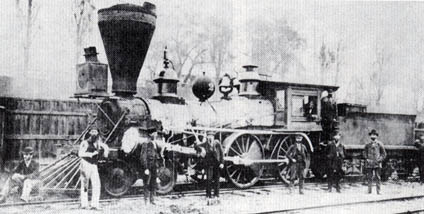Vol. 17 No. 6
June, 1987
|
Stay Safe in 87
|
|

Engineering Institute
Celebrates Centennial
|

Omer Lavallee
|

The first Canadian-built steam locomotive,
"Toronto".
This year marks the centennial of the
establishment of the first Canadian organization for professional engineers, the Engineering Institute of Canada. The
engineering fraternity in many centers across the country is having gatherings and conferences to mark this important
anniversary.
In February, I participated in one such conference, held in Thunder Bay, at which I delivered a paper on the subject
of the building of the CP Rail main line along the North shore of Lake Superior between 1883 and 1885.
In referring to this anniversary, an engineer friend of mine called it "the centennial of engineering in
Canada". I gagged a bit on that one, even though I new what he had intended to say. In fact, in the
"unorganized" (pre-1887) era of the profession, there were many important engineering
achievements, several of them nothing less than spectacular. It seems appropriate to devote this column to identify
some of them.
Up to the birth of the Industrial Revolution, generally reckoned to have begun about 1760, engineering was almost
always associated with military operations. Back then, those engaged in non-combative works, such as the
construction of factories, railways, and canals, began to style themselves "civil" engineers, to distance
themselves from their military counterparts. The Industrial Revolution marked the birth of modern technology,
introducing another branch of science, mechanical engineering.
The pre-eminence of British North America in this respect - particularly in the realm of transportation
- was demonstrated by the steam boat "Accommodation" launched at Montreal in 1809 by John Molson, the
city's pioneer (1786) brewer. This vessel was the world's third commercially-successful steamer. The
other two, introduced in the United States in 1807 and 1808 respectively, used engines built by Boulton & Watt
in London, England.
However, the Molson steamer's engine was made in its native city using castings poured at the old St. Maurice Forges
near Trois-Rivieres.
Though the locomotives and passenger cars used on Canada's first public railway in 1836 were built in Great Britain
and in the USA respectively, Ward's Eagle Foundry in Montreal built the line's first freight cars. The manufacture
of passenger cars started in Montreal in 1847, when the Montreal and Lachine Rail-Road built its own
rolling stock using day labour for the car bodies, though the castings for wheels, axles, and suspension were
imported from the United Kingdom.
The first Canadian-built steam locomotive, named "Toronto" and ordered by the Ontario, Simcoe
& Huron Union Railroad in 1853, was made by James Good in its namesake city. In the autumn of that year, the
Kinmond Brothers from Dundee, Scotland founded a "locomotive manufactory" in Montreal. In 1856, a
locomotive factory was established in Kingston, Ontario; known later as Canadian Locomotive Works, it remained in
production for well over a century.
The crowning civil engineering achievement of the pre-Confederation period was the Victoria Tubular
Bridge at Montreal. About two kilometres in length, it carried the Grand Trunk Railway over the St. Lawrence River.
It officially was opened by the Prince of Wales, later King Edward VII, in 1860. In the same year, Canada's first
railway tunnel, a little over 500 metres in length under the town of Brockville, Ontario, was placed in service by
the Brockville & Ottawa Railway.
Confederation in 1867 stimulated the building of a transcontinental railway system. The Intercolonial Railway,
connecting Ontario and Quebec with Halifax, was completed in 1875; the Canadian Pacific, with its steel link through
to the Pacific Coast, was finished 10 years later. These long distance lines encountered engineering challenges as
formidable as any elsewhere in the world.
Regrettably, space does not permit even a cursory listing of the many talented individuals who were responsible for
meeting and overcoming these challenges. However, all Canadian railway historians owe a debt of gratitude to Samuel
Keefer (1811-1890), an engineer who was appointed Inspector of Railways for the Province of Canada in
1858. The resulting highly-detailed Keefer Reports, compiled for 1858, 1859, and 1860, covered matters
as diverse as finance, operations, motive power, rolling stock, and engineering. The existence of these reports, the
equivalent, in their field, of the famed "Rosetta Stone", was not known until the late 1940's.
Incidentally, Samuel Keefer's half-brother, Thomas Coltrin Keefer (1821-1915), was the
first president of the Canadian Society of Civil Engineers when it was established in 1887.
This CP Rail News article is copyright
1987 by the Canadian Pacific Railway and is reprinted here with
their permission. All photographs, logos, and trademarks are the property of the Canadian Pacific Railway
Company.
|